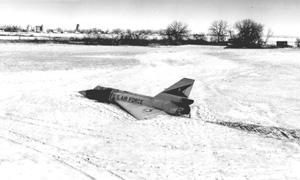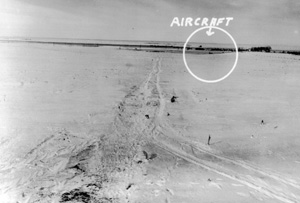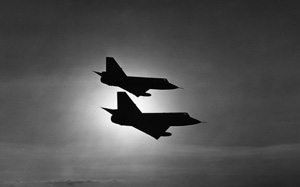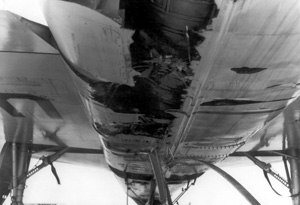In the Cold War Gallery of the National Museum of the US Air Force, one comes across a sleek F-106 interceptor from a long-gone era. Its outward appearance is not unusual. True, it is a sharp-featured, delta-wing beauty, but that is how all of the USAF “Sixes” looked.
However, this particular F-106 possesses a history that is truly extraordinary. That is because this Delta Dart once lost its pilot yet still managed to land itself safely.
This is no joke. During a Feb. 2, 1970 training mission that originated at Malmstrom AFB, Mont., F-106A #58-0787 suddenly entered an uncontrollable flat spin, and its pilot was forced to eject.
 |
The famous F-106 lies in the snowy field where it landed. |
Rather than plunge into a frozen field, however, the aircraft suddenly recovered. Sans pilot, it eventually made a gentle belly landing on open land near Big Sandy, Mont. Relatively gentle, in any case. The landing was smooth enough that its jet engine was still running when a local law enforcement officer arrived on the scene.
After repairs, No. 58-0787 served several more years in California and New York before eventually finding its way to the museum at Wright-Patterson AFB, Ohio, in 1986.
By all rights, this “Six” should have ended its days as shards of metal scattered over a square mile or so of the northern Great Plains. Instead, it sits amidst other military aircraft from a time of great tension between superpowers, reminding visitors that aircraft with the speed and range to intercept Soviet manned bombers were once an integral part of US national security.
The F-106 was one of the star performers of the first generation of true supersonic USAF fighters, the famed “Century Series” that included the North American F-100, McDonnell F-101, Convair F-102, Lockheed F-104, Republic F-105, and Convair F-106.
The F-106 was a derivative of the F-102 Delta Dagger, which had a troubled development and never seemed to quite live up to the Air Force’s expectations for performance. Originally dubbed the F-102B, the F-106 eventually received its own designation and its official nickname, Delta Dart. To most who flew it and worked on it, however, it was simply the “Six.”
Perhaps the most significant basic difference between the F-102 and the F-106 was in fuselage shape. The Delta Dagger had a somewhat bulky cross section. The Six, by contrast, had a slim, aerodynamically advanced area-rule fuselage, whose pointy cigar shape helped minimize drag-inducing shock waves at supersonic speeds.
The F-106 also featured a more powerful Pratt & Whitney J75 after-burning turbojet. Almost from its first flight in December 1956, the aircraft showed that it would easily meet the Air Force’s requirements for a speed of Mach 1.9 and ceiling of 57,000 feet.
“Finally, by the end of the ’50s, the US Air Force had the long sought after ‘ultimate interceptor’ it had anticipated in the late ’40s,” wrote Christopher T. Carey, a historian at the McClellan Aviation Museum (now Aerospace Museum of California), in his online history of F-106 development.
The need for such an interceptor was obvious to US defense officials, who were watching with concern the Soviet Union’s development of faster, long-range nuclear bombers. The Six’s job would be to run down such intruders, if necessary, and then destroy them with an atomic weapon of its own, a Genie nuclear-tipped rocket.
This blunderbuss approach to air defense was necessary because precision air-to-air weapons had yet to be invented. Instead, F-106 pilots were to launch their Genie toward the target with a characteristic looping motion, then flee, to get as far away as possible prior to detonation.
When it first entered the Air Force inventory, flying the F-106 was a revelation. Maximum speed was Mach 2.31 at 42,431 feet. “Ask any pilot who has piloted the Six, and he will quite readily tell you that it was one of the best aircraft he has ever flown,” wrote Carey.
Handling the delta wing felt much the same as handling more conventional designs. Plus, the delta wing gave more agility at low and intermediate speeds.
Pitch responsiveness was feather light. The F-106’s reaction as it came close to stalling was predictable, beginning with light buffeting and then progressing to worse things. At that point, any increase in angle of attack would lead to severe oscillation and, in all likelihood, a flat spin.
 |
A track in the snow shows the path the Dart took as it slid across a frozen field. |
Two-vs.-One Training
Like any high-performance aircraft, the Six could cause serious trouble for a pilot who pushed its flight envelope. And the Six had some inherent problems as well.
“Despite the level of sophistication found in the F-106A Delta Dart in its service life, it was regarded by the US Air Force as having the ‘greatest mission-task loaded cockpit’ among [the] types flown in the ’70s,” wrote Carey. “Despite being an excellent aircraft to fly, it required a competent and proficient pilot to wring every bit of its excellence out of it.”
Originally, the mission that February day nearly four decades ago was to be a two vs. two air combat training flight, featuring four F-106s from the 71st Fighter Interceptor Squadron at Malmstrom. One aircraft subsequently aborted from the mission when its drag chute deployed on the ramp. So the day’s training activity became a “two vs. one” fight.
The “one” on this eventful day was Tom Curtis. The “two” were 1st Lt. Gary Foust and Maj. Jim Lowe.
The sides split up, each proceeding to their end of the training air space—about a 20-mile separation. Then they turned into each other, so they would pass head on, with a thousand-foot separation between them.
The rules of engagement were that neither Curtis, nor Foust and Lowe, could try to gain an advantage until they blew past each other. Then the fight would be on.
The point of the exercise was to outmaneuver one’s opponent, and gain a valid firing position. “Of course, this was a big ego thing, who was the winner, etc.,” said Curtis in his recollection of the incident found at the Web site www.F-106DeltaDart.com. “I figured I could handle Gary pretty easy, but I did not trust Jimmy.”
So Curtis came at his opponents in full afterburner, doing Mach 1.9 when they passed. Then he took his opponents straight up to 38,000 feet.
“We got into a vertical rolling scissors. I gave him a high-G rudder reversal,” said Curtis, referring to Foust. “He tried to stay with me, [but] that’s when he lost it.” Foust’s Delta Dart began to spin out of control.
Foust experienced post-stall gyration, a situation in which an aircraft can roll left and right and suddenly swap ends. His attempts to regain control failed, and the fighter went into a flat spin at 35,000 feet, according to a 1978 article in the Griffiss AFB, N.Y., Mohawk Flyer (The fighter was by then in service at Griffiss). Usually, that kind of situation is unrecoverable.
“The aircraft looked like the pitot tube was stationary, with the aircraft rotating around it,” said Curtis. “Very flat” and slowly rotating.
Foust rode the aircraft down to 15,000 feet, all the while trying spin recovery procedures without success. Lowe, an instructor pilot, followed behind until the aircraft had descended to as low as 12,000 feet.
“Eject your drag chute,” Lowe instructed, according to the Mohawk Flyer. The newspaper went on to say that “the idea didn’t work,” and that “the chute flapped in the air and wrapped itself around the plane’s tail.”
It was time to eject. By this time, though, Foust had gone through many recovery procedures. One of these was to actuate the take-off trim button, which trimmed all control surfaces to a take-off setting. The trim settings for a landing were similar.
 |
Two F-106s form up during a late 1960s interceptor mission. |
Two Safe Landings
“When Gary ejected, the aircraft was trimmed wings-level for about 175 knots [200 mph], a very nice glide setting,” said Curtis.
So, when Foust finally ejected—miracle of miracles—the Six recovered and headed off straight and level toward the horizon. Perhaps it was the change in balance, or the force of the ejector seat against the fuselage, or the change in aerodynamics caused by the ejection process.
Whatever it was, Lowe is said to have yelled into his radio, “Gary, you better get back in it!”
At that point, all that Foust could do was watch as his fighter flew off, without him.
Gary Foust, dangling from his parachute ropes, landed safely in a mountainous area and was brought out later by locals on snowmobiles. This, after all, was February in Montana.
As the fighter neared the ground, it stayed level and made what is described as an approach for a perfect landing in a snowy field, sans landing gear.
The F-106 wasn’t safe yet, however. “Skidding across the snow, the aircraft veered around a rock pile that was sitting in the middle of the field,” the Mohawk Flyer reported. “The -106 finally stopped near the end of the field, about 400 yards from a paved road.”
A local law enforcement officer called Malmstrom to report that he had come upon a fighter that was on the ground, pilotless, and still running. Even the radar scope was still operating. The lawman wanted to know how to turn off the engine. Someone at the base told him to just let it run out of fuel.
The engine continued to run for one hour and 45 minutes.
The landing did a bit of damage to the fighter’s underside, ripping open an ugly gash several yards long. The wings, in contrast, were fine.
In time, a team of technicians from the Sacramento Air Logistics Center at McClellan AFB, Calif., came to the site and partially disassembled the Six. They trucked the pieces to a nearby rail line, loaded it onto a flatcar, and shipped the whole thing to California. There, Air Force workers repaired it and returned it to active service.
The F-106’s final service was with the 49th Fighter Interceptor Squadron, at Griffiss—the last active Air Force F-106 unit.
 |
The undercarriage of the F-106 was damaged in the landing near Big Sandy, Mont. It could have been a lot worse. (Photo via www.f-106deltadart.com) |
By the 1970s, the USSR’s increasing reliance on intercontinental ballistic missiles for its nuclear deterrence had lessened the US need for speedy interceptors such as the F-106. In the end, the Delta Dart did not serve in Vietnam, nor did it ever fire a shot in anger. The F-15 began replacing it in 1972, with the Sixes typically being passed along to Air National Guard units. The last F-106 that remained in Air Force service was retired in 1988.
Convair produced about 340 of the fighters for the Air Force. Starting in the late 1980s, about 230 of the surviving airframes were converted into QF-106 drone configuration and used for target practice. Thus the last of the pure air defense interceptors was relegated to aerospace history.
On at least one occasion, however, the F-106 proved that it was an aircraft that didn’t even need a pilot. The fighter that somehow accidentally righted itself and landed on its own—wheels up—is now a museum piece. Rightly so.
